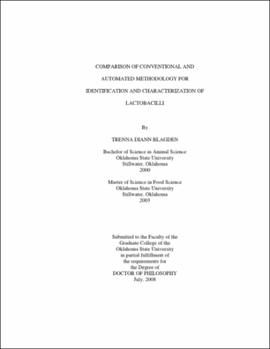| dc.contributor.advisor | Gilliland, Stanley E. | |
| dc.contributor.author | Blagden, Trenna Diann | |
| dc.date.accessioned | 2013-11-26T08:22:32Z | |
| dc.date.available | 2013-11-26T08:22:32Z | |
| dc.date.issued | 2008-07 | |
| dc.identifier.uri | https://hdl.handle.net/11244/6587 | |
| dc.description.abstract | Scope and Method of Study: Numerous potential health benefits of consumption of products containing probiotics have been highlighted in research for many years. More recently, the prospective role probiotics may offer in response to antibiotic resistance and other medical issues has become a topic of interest. Methods that appropriately identify and characterize lactobacilli to fully understand the potential of probiotic strains based on metabolic activities as well as host specificity is a necessity. Attention is now focused on comparing various automated systems and conventional methodology for identification and characterization capable of distinguishing host specificity and selection of a probiotic strain for use as treatments or answers in modern medicine or as supplements for healthy living. | |
| dc.description.abstract | Findings and Conclusions: Thirty-two previously isolated cultures of lactobacilli were analyzed using various methodologies in an effort to rapidly identify and further classify their probiotic potential. The results obtained from the Vitek and the RiboPrinter systems were inconclusive and failed to provide reliable, reproducible identifications for these isolates. The Biolog and Sherlock MIDI MIS systems demonstrated potential for use as tools to identify and characterize isolates of lactobacilli. The Biology and Sherlock MIDI MIS systems provided positive identifications of the isolates at a species level. However, these two systems were unable to reliably provide the same species identification within a series of replications. In both systems it was observed that the top choices were more often switched in order from one replication to the next. The Sherlock MIDI MIS system appeared to offer the most potential for characterization of the strains given a positive identification was made by the system. Use of a larger pool and variety within strains in development of the databases or libraries for the automated systems, along with culture preparation techniques specific to lactobacilli would greatly enhance the applicability of some of these automated systems for use in appropriately identifying and characterizing the probiotic potential of isolates of lactobacilli. | |
| dc.format | application/pdf | |
| dc.language | en_US | |
| dc.rights | Copyright is held by the author who has granted the Oklahoma State University Library the non-exclusive right to share this material in its institutional repository. Contact Digital Library Services at lib-dls@okstate.edu or 405-744-9161 for the permission policy on the use, reproduction or distribution of this material. | |
| dc.title | Comparison of conventional and automated methodology for identification and characterization of lactobacilli | |
| dc.contributor.committeeMember | McGlynn, William G. | |
| dc.contributor.committeeMember | DeWitt, Christina | |
| dc.contributor.committeeMember | Burnham, David Kim | |
| osu.filename | Blagden_okstate_0664D_2790.pdf | |
| osu.accesstype | Open Access | |
| dc.type.genre | Dissertation | |
| dc.type.material | Text | |
| dc.subject.keywords | probiotic | |
| dc.subject.keywords | Lactobacillus | |
| dc.subject.keywords | lactobacilli | |
| dc.subject.keywords | acidophilus | |
| dc.subject.keywords | casei | |
| thesis.degree.discipline | Food Science | |
| thesis.degree.grantor | Oklahoma State University | |
